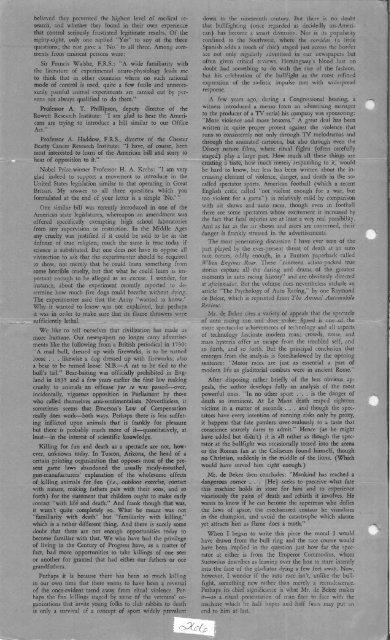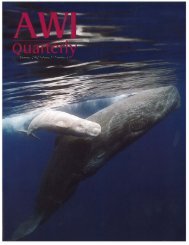AT ION - Animal Welfare Institute
AT ION - Animal Welfare Institute
AT ION - Animal Welfare Institute
You also want an ePaper? Increase the reach of your titles
YUMPU automatically turns print PDFs into web optimized ePapers that Google loves.
elieved they prevented the highest level of medical research,<br />
and whether they found in their own experience<br />
that control seriously frustrated legitimate results. Of the<br />
eighty-eight, only one replied "Yes" to any of the three<br />
questions; the rest gave a "No" to all three. Among comments<br />
from eminent persons were:<br />
Sir Francis Walshe, F.R.S.: "A wide familiarity with<br />
the literature of experimental neuro-physiology leads me<br />
to think that in other countries where no such rational<br />
mode of control is used, quite a few futile and unnecessarily<br />
painful animal experiments are carried out by persons<br />
not always qualified to do them."<br />
Professor A. T. Phillipson, deputy director of the<br />
Rowett Research <strong>Institute</strong>: "I am glad to hear the Americans<br />
are trying to introduce a bill similar to our Office<br />
Act."<br />
Professor A. Haddow, F.R.S., director of the Chester<br />
Beatty Cancer Research <strong>Institute</strong>: "I have, of course, been<br />
most interested to learn of the American bill and sorry to<br />
hear of opposition to it."<br />
Nobel Prize-winner Professor H. A. Krebs: "I am very<br />
glad indeed to support a movement to introduce in the<br />
United States legislation similar to that operating in Great<br />
Britain. My answer to all three questions which you<br />
formulated at the end of your letter is a simple 'No.'<br />
One similar bill was recently introduced in one of the<br />
American state legislatures, whereupon an amendment was<br />
offered specifically exempting high school laboratories<br />
from any supervision or restriction. In the Middle Ages<br />
any cruelty was justified if it could be said to be in the<br />
defense of true religion; much the same is true today if<br />
science is substituted. But one does not have to oppose all<br />
vivisection to ask that the experimenter should be required<br />
to show, not merely that he could learn something from<br />
some horrible cruelty, but that what he could learn is important<br />
enough to be alleged as an excuse. I wonder, for<br />
instance, about the experiment recently reported to determine<br />
how much fire dogs could breathe without dying.<br />
The experimenter said that the Army "wanted to know."<br />
Why it wanted to know was not explained, but perhaps<br />
it was in order to make sure that its flame throwers were<br />
sufficiently lethal.<br />
We like to tell ourselves that civilization has made us<br />
more humane. Our newspapers no longer carry advertisements<br />
like the following from a British periodical in 1730:<br />
"A mad bull, dressed up with fireworks, is to be turned<br />
loose . . . likewise a dog dressed up with fireworks; also<br />
a bear to be turned loose. N.B.—A cat to be tied to the<br />
bull's tail." Bear-baiting was officially prohibited in England<br />
in 1835 and a few years earlier the first law making<br />
cruelty to animals an offense per se was passed—over,<br />
incidentally, vigorous opposition in Parliament by those<br />
who called themselves anti-sentimentalists. Nevertheless, it<br />
sometimes seems that Emerson's Law of Compensation<br />
really does work—both ways. Perhaps there is less suffering<br />
inflicted upon animals that is frankly for pleasure<br />
but there is probably much more of it—quantitatively, at<br />
least—in the interest of scientific knowledge.<br />
Killing for fun and death as a spectacle are not, however,<br />
unknown today. In Tuscon, Arizona, the head of a<br />
certain printing organization that opposes most of the present<br />
game laws abandoned the usually mealy-mouthed,<br />
gun-manufacturers' explanation of the wholesome effects<br />
of killing animals for _fun (i.e., outdoor exercise, contact<br />
with nature, making fathers pals with their sons, and so<br />
forth) for the statement that children ought to make early<br />
contact "with life and death." And frank though that was,<br />
it wasn't quite completely so. What he meant was not<br />
"familiarity with death" but "familiarity with killing,"<br />
which is a rather different thing. And there is surely some<br />
doubt that there are not enough opportunities today to<br />
become familiar with that. We who have had the privilege<br />
of living in the Century of Progress have, as a matter of<br />
fact, had more opportunities to take killings of one sort<br />
or another for granted that had either our fathers or our<br />
grandfathers.<br />
Perhaps it is because there has been so much killing<br />
in our own time that there seems to have been a reversal<br />
of the once-evident trend away from ritual violence. Perhaps<br />
the fun killings staged by some of the veterans' organizations<br />
that invite young folks to club rabbits to death<br />
is only a survival of a concept of sport widely prevalent<br />
down to the nineteenth century. But there is no doubt<br />
that bullfighting (once regarded as decidedly un-American)<br />
has become a smart diversion. Nor is its popularity<br />
confined to the Southwest, where the corridas (a little<br />
Spanish adds a touch of chic) staged just across the border<br />
are not only regularly advertised in our newspapers but<br />
often given critical reviews. Hemingway's blood lust no<br />
doubt had something to do with the rise of the fashion,<br />
but his celebration of the bullfight as the most refined<br />
expression of the sadistic impulse met with widespread<br />
response.<br />
A few years ago, during a Congressional hearing, a<br />
witness introduced a memo from an advertising manager<br />
to the producer of a TV serial his company was sponsoring:<br />
"More violence and more bosoms." A great deal has been<br />
written in quite proper protest against the violence that<br />
runs so consistently not only through TV melodramas and<br />
through the animated cartoons, but also through even the<br />
Disney nature films, where ritual fights (often carefully<br />
staged) play a large part. How much all these things are<br />
creating a taste, how much merely responding to it, would<br />
be hard to know, but less has been written about the increasing<br />
element of violence, danger, and death in the socalled<br />
spectator sports. American football (which a recent<br />
English critic called "not violent enough for a war, but<br />
too violent for a game") is relatively mild by comparison<br />
with air shows and auto races, though even in football<br />
there are some spectators whose excitement is increased by<br />
the fad that fatal injuries are at least a very real possibility.<br />
And as far as the air shows and races are concerned, their<br />
danger is frankly stressed in the advertisements,<br />
The most penetrating discussion I have ever seen of the<br />
part played by the ever-present threat of death at an auto<br />
race occurs, oddly enough, in a Bantam paperback called<br />
When Engines Roar. These "nineteen action-packed true<br />
stories capture all the daring and drama of the greatest<br />
moments in auto racing history" and are obviously directed<br />
at aficionados. But the volume does nevertheless include an<br />
article "The Psychology of Auto Racing," by one Raymond<br />
de Beker, which is reprinted from The Annual Automobile<br />
Review.<br />
Mr. de Beker cites a variety of appeals that the spectacle<br />
of auto racing can and does make: Speed is one of the<br />
more spectacular achievements of technology and all aspects<br />
of technology fascinate modern man; crowds, noise, and<br />
mass hysteria offer an escape from the troubled self, and<br />
so forth, and so forth. But the principal conclusion that<br />
emerges from the analysis is foreshadowed by the opening<br />
sentence: "Motor races are just as essential a part of<br />
modern life as gladitorial combats were in ancient Rome."<br />
After disposing rather briefly of the less obvious appeals,<br />
the author develops fully an analysis of the most<br />
powerful ones. "In no other sport . . . is the danger of<br />
death so imminent. At Le Mans death reaped eighteen<br />
victims in a matter of seconds . . . and though the spectators<br />
have every intention of running risks only by proxy,<br />
it happens that fate panders over-zealously to a taste that<br />
conscience scarcely dares to admit." Hence (as he might<br />
have added but didn't) it is all rather as though the spectator<br />
at the bullfight was occasionally tossed into the arena<br />
or the Roman fan at the Coliseum found himself, though<br />
no Christian, suddenly in the middle of the lions. (Which<br />
would have served him right enough.)<br />
Mr. de Beker then concludes: "Mankind has reached a<br />
dangerous corner . . . [He] seeks to preceive what fate<br />
this machine holds in store for him and to experience<br />
vicariously the pains of death and rebirth it involves. He<br />
wants to know if he can become the superman who defies<br />
the laws of space, the mechanized centaur he visualizes<br />
in the champion, and avoid the catastrophe which alarms<br />
yet attracts him as flame does a moth."<br />
When I began to write this piece the moral I would<br />
have drawn from the bull ring and the race course would<br />
have been implied in the question just how far the spectator<br />
at either is from the Emperor Commodius, whom<br />
Suetonius describes as leaning over the box to stare intently<br />
into the face of the gladiator dying a few feet away. Now,<br />
however, I wonder if the auto race isn't, unlike the bullfight,<br />
something new rather than merely a recrudescence.<br />
Perhaps its chief significance is what Mr. de Beker makes<br />
it—as a ritual presentation of man face to face with the<br />
machine which he half hopes and half fears may put an<br />
end to him at last.

















